●
●
●


 Products
Products R&D
R&D Manufacturing Technologies
Manufacturing Technologies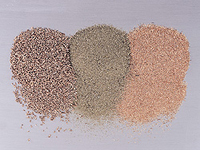 |
Copper is obtained from copper ore and copper scrap. Copper ore has three sorts that is copper sulfide, copper oxide and native copper. Native copper and copper sulfide are secondary products of copper sulfide, which accounts for 65% of all the copper ore.
Alomost all of copper sulfide is to be transformed into pure copper through pyroprocessing, however, copper sulfide cannot be reduced as it is. In this regard, it is to be reduced in blast furnace, reverberatory furnace or flash furnace to matte of which copper content is 30 to 50%. Subsequently, the matte is to be reduced in to crude copper of 98%Cu then finally to electrolytic copper of 99.9%Cu through electrolytic refining. |
|
Raw material of production of copper and copper alloys includes ingots such as electrolytic copper and zinc and scrap. Scrap may be, again, divided into lumps produced from manufacturing process, chips in the form of powder scattered from cutting work and waste products after use. Copper alloy industry should be basically termed recycling industry in view of the fact that such scrap is to be collected to be melted, together with electrolytic copper and zinc ingots, then to be cast; it is also a pro-environment industry from the point of view of the recent Green Round regime that globally puts a special emphasis on importance of resources recycling. In conclusion, copper alloy industry is a processing one in which coper, as main material, is melted and cast together with zinc, lead, tin, nickel, etc., as subsidiary materials, and processed via pressing, extruding, drawing, etc., to be final products including plate, tape, rod, pipe, wire, etc.
|
 |
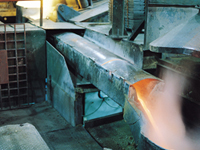 |
At large, crucible furnace or low frequency induction furnace is employed in melting. Gases emission during brass melting is not a significant issue, however zinc evaporation, of which melting point is rather low, is. This is why retrofitting dust collecting facilities and recycling the fly ahses caught should be implemented in order to resolve pollution problems. Zinc oxide content in fly ashes is as usual 40 to 60%.
Low frequency induction furnace may be devided into crucible and channel type according to its shape. |
| Classification | Crucible type | Channel type |
| Structure | Basic structure fixed | Modifiable |
| Heat Generating and Melting Chamber | Integrated | Separable |
| Furance Capacity/Tapping Quantity | 6 ton/3.5 ton, 7.5 ton/3.5 ton | 8 ton/3.5 ton |
| Furance Life | 3 to 6 months | 12 to 24 months |
| Remaining Melt | Not necessary | Necessory |
| Operation Mode | Randomly Discrete Operation | Continuous Operation in Principle |
| Change in Composition | Easy | Difficult |
| Agitation Force | Strong | Weak |
| Scrap Type | Chips and Lumps | Lumps |
|
Metal is melted in a crucible furnace by Joule heat supplied via coil twined around the furnace on the outer surface. It can resume melting process with solid raw materials and is suitable to mass customization, however shows lower thermal efficiency than that of a channel furnace. As integrated structure that maintains the original structure, it has a short life time while it does not require molten metal to remain in it and modifies the composition with ease, which makes possible discrete operation. Agitation is to occur around the center of coil length at which the magnetic flux density is the highest, which accounts for compression of flux, input in order to cover the melt surface, on the inner wall surface of the furnace, which often wears down refractory, oxidizes melt and induces turbulence of oxide. It does not require molten metal to remain in it and modifies the composition with ease, which makes possible discrete operation. Small cutting chips, other than lumps, are flavorable to this furnace due to its strong agitation.
|
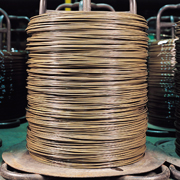 |
|
Target metal is to be melted in a circle located at the secondary coil-equivalent place of single phase AC transformer by means of the secondary current induced by the primary current input from the primary coil. A low frequency of 50 or 60 Hz is applied to the furnace, which has more capacity than that of crucible type one. Structure modification made easy separates heat generating chamber and melting chamber, which doesn’t put a limitation on power capacity. Furnace life counts one or two years. It should be serviced in continuous operaion mode with less melt change in principle since it requires molten metal to remain for the next melting and be suitable to change minimized in the composition. Its weak agitation explains the feed-in of scrap as lumps.
|
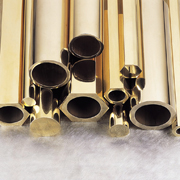 |
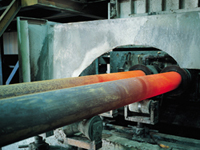 |
Casting is a process to manufacture ingots as semi-product or castings of the final product from molten metal, while ingot, as a material to form products including rod, wire, plate and pipe via plastic working such as extrusion and rolling, shall be differentiated from the casting.
Continuous casting method is employed in copper and copper alloy industry as usual for the sake of mass production and improved quality. Continuous casting is, again, divided into vertical continous casting, VCC and horizontal continous casting, HCC. |
| Classification | Vertical Half-Continuous Casting Machine | Horizontal Continuous Casting Machine |
| Structure | Metling furnace - Casting machine | Metling furnace - Holding furnace - Casting machine - Drawing device - Cutting machine |
| Operation Mode | Discrete Operation | Continuous Operation |
| Material Change | Easy | Removal of changed part |
| Production Property | Mass Customization | Mass Production |
| Number of Ingots | 2~4 strand | 1~3 strand |
| Mould | Copper | Copper + Graphite |
| Cooling Equipment | Mould, spray, water bath | Mould, spray |
| Ingot Drawing Machine | Self-weight type by cylinder | Self-propelling type by pinch roll |
| Billet Surface | Good | Good; Surface ground |
|
Metal is melted in a crucible furnace by Joule heat supplied via coil twined around the furnace on the outer surface. It can resume melting process with solid raw materials and is suitable to mass customization, however shows lower thermal efficiency than that of a channel furnace. As integrated structure that maintains the original structure, it has a short life time while it does not require molten metal to remain in it and modifies the composition with ease, which makes possible discrete operation. Agitation is to occur around the center of coil length at which the magnetic flux density is the highest, which accounts for compression of flux, input in order to cover the melt surface, on the inner wall surface of the furnace, which often wears down refractory, oxidizes melt and induces turbulence of oxide. It does not require molten metal to remain in it and modifies the composition with ease, which makes possible discrete operation. Small cutting chips, other than lumps, are flavorable to this furnace due to its strong agitation.
|
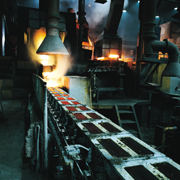 |
|
Ingot is to be drawn horizontally, making the best use of the self-lubrication and thermal conductivity inherent in graphite, out of graphite mould which is cooled at the lower part of holding furnace. This method is applied to manufacturing of rod, plate and pipe. The facilities consist of, as those of vertical continuous casting do, melting furnace, holding furnace, casting machine, drawing device and cutter. Since this is favorable to mass production, crucible type induction furnace is employed as usual in this process. Chips and scrap respresents 80 and 20% of the raw material, respectively. Rod and pipe is manufactured by precise casting and requires less cutting process. Pertinent plant construction does not require high roof, which accounts for the low facility costs of this method.
|
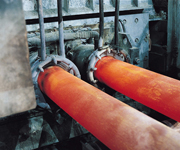 |
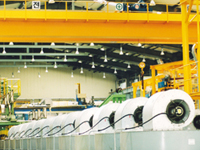 |
Extrusion is a process in which material is compressed in the container then extruded out of a die hole to have desired crosssection with less area than that of original one. This method is mainly employed for hot working of nonferrous metals and manufacturing hot materials with low deformability since the billet is to be subject to considerable compressive strength in the container and die. Its simple process and high extruding force may secure dense products with improved mechanical properties. Extrusion is classified to direct extrusion in which products are to come out along the direction of pressure imposition and indirect extrusion in which the direction is reversed, respectively.
|
| Classification | Vertical Half-Continuous Casting Machine | Horizontal Continuous Casting Machine |
| Structure | Simple; general manufacturing method | Complicated; difficult to maintain the facilities |
| Extrusion Direction | Same as stem proceeding | Opposite to stem proceeding |
| Friction | Friction; heavy loss of power | Low relative movement; light loss of power |
| Dead zone | Wide | Narrow |
| Billet Oxidization Layer | Significant diffusion | Defect minimized due to less flow |
| Defect | Piping defect | Frequently covered with scale |
| Shell Thickness | 1 to 2 mm | 1 to 2 mm |
| Discard Length | 20% of billet diameter | 10% of billet diameter |
| Length of Piping Removed | Tail part, 2 to 3% of whole length | - |
| Yield Rate | 80% | 92% |
|
Sometimes termed forward extrusion, this is same in principle as tooth paste squeezing. Billet is to move relatively against the container wall, which induces huge ram load caused by the friction. The last part of the process may lose the value of desired product due to piping defects generated at the center or inside of extruded rod, caused by the metal flow. To eliminate such problem, the last part of billet is to be discarded, which accounts for the low yield rate of this process. Moreover, mechanical properties may deviate along the rod produced due to the temperature difference between early and later stage of the process. To minimize such problem, it is necessary to improve gradient heating method of billet or post-process cooling method.
|
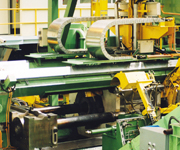 |
|
Often termed backward extrusion, this method shows nealy no friction between billet and the container wall since the die is to move toward billet or the container of billet is to move independently with die-supporting stem fixed. This explains the low power consumption for extrusion and workability at lower temperature. Being favorable to mass production and with fewer defects caused by crack in metal flow, this method exhibits a higher yield rate.
|
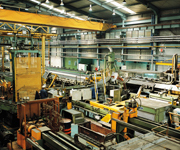 |
